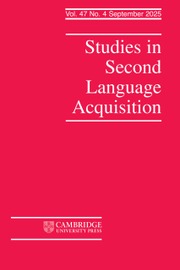Article contents
VOCABULARY SIZE IS ASSOCIATED WITH SECOND-LANGUAGE VOWEL PERCEPTION PERFORMANCE IN ADULT LEARNERS
Published online by Cambridge University Press: 20 July 2011
Abstract
Improvement in second-language (L2) perception has been posited to occur early in L2 learning when the L2 vocabulary is still small, whereas a large L2 vocabulary curtails perceptual learning (the perceptual assimilation model for SLA [PAM-L2]; Best & Tyler, 2007). This proposition is extended by suggesting that early L2 lexical development facilitates the establishment of phonological categories in a manner analogous to children’s first-language (L1) acquisition before as opposed to after the vocabulary spurt. According to this view, L2 speech should be assimilated more consistently to L1 phonological categories and cross-boundary contrasts should be discriminated more accurately by learners with larger L2 vocabularies. To test this proposition, a novel whole-system approach to evaluate perception of L2 vowels in two experiments was applied. In Experiment 1, Japanese learners of Australian English (AusE) with less than 12 weeks of L2 learning in Australia completed labeling and goodness ratings on all AusE vowels, selecting from among all monomoraic and bimoraic Japanese vowels and vowel combinations. They also discriminated four L2 vowel contrasts, representing a range of PAM-L2 contrast types, and completed a L2 vocabulary size assessment. Learners with larger vocabularies had more consistent L2-L1 vowel assimilation and more accurate cross-boundary discrimination than those with smaller vocabularies, supporting the proposition that lexical development assists L2 phonological acquisition. Experiment 2 compared the perception of AusE vowels by Japanese learners after only 4–8 weeks in Australia with their perception after 6–8 months of L2 exposure. The results also supported the predicted positive association between L2 vocabulary size and L2 vowel perception rather than a general prediction of increased exposure duration leading to improved perception.
Information
- Type
- Research Articles
- Information
- Copyright
- Copyright © Cambridge University Press 2011
References
REFERENCES
- 78
- Cited by

